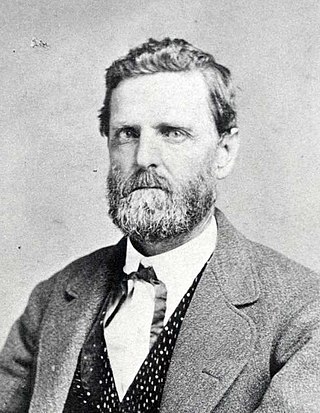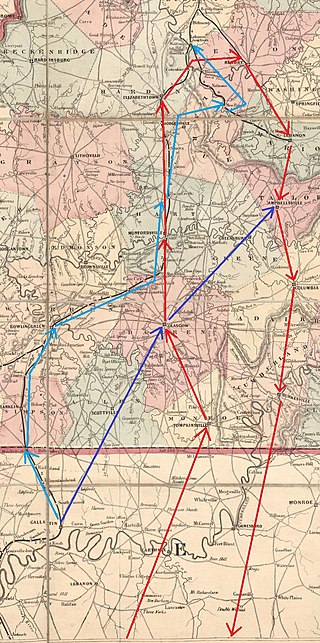
The Battle of Atlanta took place during the Atlanta Campaign of the American Civil War on July 22, 1864, just southeast of Atlanta, Georgia. Continuing their summer campaign to seize the important rail and supply hub of Atlanta, Union forces commanded by William Tecumseh Sherman overwhelmed and defeated Confederate forces defending the city under John Bell Hood. Union Major General James B. McPherson was killed during the battle, the second-highest-ranking Union officer killed in action during the war. Despite the implication of finality in its name, the battle occurred midway through the Atlanta campaign, and the city did not fall until September 2, 1864, after a Union siege and various attempts to seize railroads and supply lines leading to Atlanta. After taking the city, Sherman's troops headed south-southeastward toward Milledgeville, the state capital, and on to Savannah with the March to the Sea.

George Stoneman Jr. was a United States Army cavalry officer and politician who served as the fifteenth governor of California from 1883 to 1887.

The Battle of Jonesborough was fought between Union Army forces led by William Tecumseh Sherman and Confederate forces under William J. Hardee during the Atlanta Campaign in the American Civil War. On the first day, on orders from Army of Tennessee commander John Bell Hood, Hardee's troops attacked the Federals and were repulsed with heavy losses. That evening, Hood ordered Hardee to send half his troops back to Atlanta. On the second day, five Union corps converged on Jonesborough. For the only time during the Atlanta Campaign, a major Federal frontal assault succeeded in breaching the Confederate defenses. The attack took 900 prisoners, but the defenders were able to halt the breakthrough and improvise new defenses. Despite facing overwhelming odds, Hardee's corps escaped undetected to the south that evening.

The Battle of Cove Mountain occurred in Wythe County, Virginia, on May 10, 1864, during the American Civil War. A Union cavalry division commanded by Brigadier General William W. Averell was prevented from attacking a lead mine located near Wytheville. Confederate forces commanded by Brigadier General John Hunt Morgan, with a detachment of a brigade of cavalry from the command of Brigadier General William E. "Grumble" Jones, stopped Averell at Cove Gap, adjacent to Crockett's Cove and Cove Mountain.

The 5th United States Colored Cavalry was a regiment of the United States Army organized as one of the units of the United States Colored Troops during the American Civil War. The 5th USCC was one of the more notable black fighting units. It was officially organized in Kentucky in October 1864, after its first two battles. It was commanded by Colonel James Brisbin until February 1865, when he took over the 6th US Colored Cavalry. His executive officer, Louis Henry Carpenter, commanded the regiment until 20 March 1866.

The western theater of the American Civil War encompassed major military operations in the states of Alabama, Georgia, Florida, Mississippi, North Carolina, Kentucky, South Carolina and Tennessee, as well as Louisiana east of the Mississippi River. Operations on the coasts of these states, except for Mobile Bay, are considered part of the Lower Seaboard Theater. Most other operations east of the Appalachian Mountains are part of the eastern theater. Operations west of the Mississippi River took place in the trans-Mississippi theater.

Alvan Cullem Gillem was a general in the Union Army during the American Civil War. Although Southern-born, he remained loyal to the Federal government and fought in several battles in the Western Theater before commanding occupation troops in Mississippi and Arkansas during Reconstruction. He later played a prominent role in the Modoc War in 1873.

The 11th Michigan Cavalry Regiment was a cavalry regiment that served in the Union Army during the American Civil War.

The Battle of Marion was a military engagement fought between units of the Union Army and the Confederate Army during the American Civil War near the town of Marion, Virginia. The battle was part of Union Maj. Gen. George Stoneman's attack upon southwest Virginia, aimed at destroying Confederate industrial infrastructure near Saltville and Marion. Union Cavalry and Infantry regiments—some 4,500 soldiers in total—left Tennessee on December 17 for southwestern Virginia.
The 3rd North Carolina (Volunteer) Mounted Infantry was an all-volunteer mounted infantry regiment that served in the Union Army during the American Civil War. The regiment was predominantly composed of Union Loyalists from North Carolina, but also included volunteers from Tennessee and several other states.
The 11th Kentucky Cavalry Regiment was a cavalry regiment that served in the Union Army during the American Civil War.
The 13th Tennessee Cavalry Regiment was a cavalry regiment that served in the Union Army during the American Civil War. The regiment was originally designated 12th Tennessee Volunteer Cavalry, but was changed by order of Governor Andrew Johnson on December 31, 1863.
The 9th Tennessee Cavalry Regiment was a cavalry regiment that served in the Union Army during the American Civil War.
The 12th Ohio Cavalry Regiment was a cavalry regiment that served in the Union Army during the American Civil War.

John Crawford Vaughn was a Confederate cavalry officer from East Tennessee. He served in the Mexican–American War, prospected in the California Gold Rush, and participated in American Civil War battles including First Manassas, Vicksburg, Piedmont and Saltville.

James Patton Brownlow was a Union Army officer during the American Civil War. Brownlow was the son of East Tennessee preacher and politician Parson Brownlow. James P. Brownlow served in several positions in the Union Army, finishing the war as colonel of the 1st Tennessee Cavalry Regiment. He was noted for his courage and perceptiveness in battle and keen sense of military tactics. Union cavalry in Tennessee, in addition to participating in crucial organized battles of the war, "primarily meant almost endless skirmishing with partisans, guerrillas, and bushwackers, as well as with the Rebel raiders of John Hunt Morgan, Joseph Wheeler, and Nathan Bedford Forrest, who frequently recruited and supplied themselves from behind enemy lines." Jim Brownlow's deft handling of these engagements left him with a reputation as "one of the greatest daredevils of the Civil War."
The Van Buren raid occurred in Crawford County, Arkansas, on December 28, 1862, during the American Civil War. After defeating Confederate forces led by Major General Thomas C. Hindman at the Battle of Prairie Grove on December 7, 1862, Union forces under Brigadiers General James G. Blunt and Francis J. Herron prepared for a raid against the Confederate positions at Van Buren and Fort Smith. Disease, lack of supplies, and desertion had previously forced Hindman to begin withdrawing most of his force from the area. Setting out on December 27, the Union troops struck an outlying Confederate cavalry unit near Drippings Spring, north of Van Buren, on the morning of December 28. The Confederate cavalry fled to Van Buren, which was then overrun by Union troops.

Charles Constantine Crews was an attorney, physician, railroad executive and Confederate Colonel in the American Civil War. Between 1862 and 1865, he participated in most of the Western Theater cavalry campaigns of Major General Joseph Wheeler, initially leading the 2nd Georgia Cavalry and eventually a cavalry brigade.
The 107th Illinois Volunteer Infantry Regiment was raised as part of the call for 300,000 volunteers in the summer and fall of 1862. It was organized on September 4, 1862, at Camp Butler near Springfield, Illinois, and was composed of men from DeWitt, Piatt, and Williamson Counties in central and southern Illinois.

Morgan's Christmas Raid was carried out by Confederate Brigadier General John Hunt Morgan between December 22, 1862, and January 5, 1863. Morgan intended to cut the supply lines to the Union Army of the Cumberland in Tennessee. The Union used the Louisville and Nashville Railroad, and Morgan had identified two 500-foot (150 m) long trestle bridges at Muldraugh Hill that could be burnt. Morgan's 4,000-strong cavalry force left Alexandria, Tennessee, on December 22 and passed into Kentucky on Christmas Eve, defeating part of the 2nd Michigan Cavalry Regiment near Tompkinsville. They fought and defeated an Indiana cavalry detachment on Christmas Day at Bear Wallow, Barren County. The U.S. Army sent forces under Colonel John Marshall Harlan and Major General Joseph J. Reynolds to try to catch Morgan. However, Morgan used ruses to distract his pursuers. Morgan captured a Union stockade at Bonnieville on December 26 and on December 27 captured Elizabethtown before burning the bridges at Muldraugh Hill.














